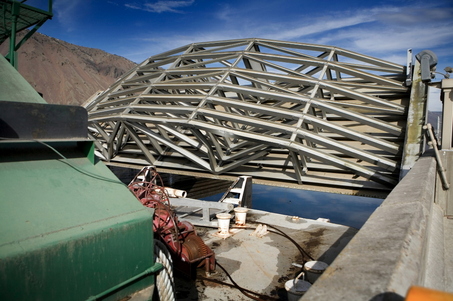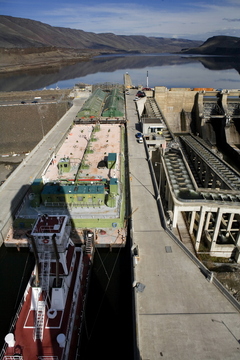forum
library
tutorial
contact

Barge Rams Lock Gate at John Day Dam,
Halting River Traffic
by Gail Kinsey Hill and Eric MortensonThe Oregonian, February 29, 2008
|
the film forum library tutorial contact |

|
Barge Rams Lock Gate at John Day Dam,
by Gail Kinsey Hill and Eric Mortenson |
 River traffic on the Columbia River between Portland and the Tri-Cities area of Washington state came to a halt Friday after two empty grain barges rammed the gate of a navigation lock at John Day Dam, east of The Dalles.
River traffic on the Columbia River between Portland and the Tri-Cities area of Washington state came to a halt Friday after two empty grain barges rammed the gate of a navigation lock at John Day Dam, east of The Dalles.
The last barge in the three-barge unit being pushed by a tugboat was loaded with 1.7 million gallons of diesel fuel. No injuries or fuel leakages were reported by the U.S. Army Corps of Engineers, which operates the dam.
The corps said late Friday it hoped to put in a temporary gate and reopen the lock by Monday.
More than 10 million tons of commodities a year move through the eight-lock system along the Snake and Columbia rivers, with the 40-year-old John Day Dam at a strategic point 25 miles upstream from The Dalles. The lock's closure highlighted the economic importance of a system that transports a dizzying array of products, including grain, gasoline, french fries and garbage.
"We're the number one wheat and barley export river system in the United States," said Josh Thomas, a spokesman for marine operations at the Port of Portland. "It's vitally important to be able to conduct trade on that system."
The mishap also underscored the condition of the dam itself, which faces a range of problems, most centered in the navigation lock, and the discovery in recent years that a layer of soft rock below the lock allows its massive 130-foot-high walls to move slightly as water is let in and out.
Early Friday, the corps sent in a team of investigators and engineers to figure out what had happened and what might be done get traffic moving again.
 A tugboat with one full diesel barge and two empty grain barges collided with an upstream gate, twisting and warping the structure and making it inoperable. The barges, owned by Tidewater Barge Lines, based in Vancouver, remained lodged in the lock late Friday. The damage to the gate was "significant," the corps reported.
A tugboat with one full diesel barge and two empty grain barges collided with an upstream gate, twisting and warping the structure and making it inoperable. The barges, owned by Tidewater Barge Lines, based in Vancouver, remained lodged in the lock late Friday. The damage to the gate was "significant," the corps reported.
Tidewater, in an announcement late Friday, said it was eager to assess the situation and begin repair work.
The corps said it would dispatch crews to lift out the broken gate Sunday and replace it with a temporary structure known as a floating bulkhead.
"We're hopeful we can reopen by Monday," said Matt Rabe, a corps spokesman. "A lot of things have to go right to make that happen."
Rabe said the damage appeared to be limited to the gate and the gate assembly. "No one has identified any structural damage to the lock itself."
Neither is the hydroelectric dam affected. At peak production, the dam is capable of producing 2.2 million kilowatts of power, enough to power two cities the size of Seattle.
The economic impact to the closure appears to be limited, especially if barges begin moving again next week.
A scheduled closure of the lock system set for March 8 to March 22 also may help dull any financial repercussions. Barge operators, businesses and port managers already were preparing for the annual maintenance closure.
"If an accident had to happen, this is pretty good timing," said Kristin Meira, a spokeswoman for the Pacific Northwest Waterways Association.
Still, shipping interests up and down the Columbia were searching for backup plans. If a fix fails in the coming days or weeks, then river traffic could be slowed or displaced to railroads and trucks, throwing a costly blow to shippers.
Gary Neal, manager of the Port of Morrow upstream from the John Day Dam, said he needs next week to adequately prepare for the two-week closure. "It's going to create a scramble situation if we can't have those days next week to get ready."
Frozen french fires, grass seed, hay, potato flakes and ethanol are among the goods that move out of his port on barges and head downriver to the Port of Portland and export markets beyond.
Items barged upriver include Clark County's garbage. Clark County, including the city of Vancouver, ships about 25 tons of garbage per month upriver to the Finley Butte landfill in Boardman.
But the county makes provisions each year to haul garbage by truck during the locks' two-week maintenance period and will simply start earlier this year, said Mike Davis, who manages the county's solid waste contracts. "It's not going to be a disaster or anything, we just have to gear up for it. I don't want to call this routine, but we're very prepared for this."
The Port of Umatilla and its shippers also are ready for the March 8 closure and have planned barge traffic accordingly, General Manager Kim Puzey said. But the sudden shutdown Friday caught them off guard.
"Normally, there is a surge of cargo trying to be scheduled around that to avoid the closure," Puzey said. "So we're in the midst of that surge, that's the problem. It's more than just an average week of inconvenience."
Three barge companies serve the port. Foss brings containers; Tidewater brings diesel fuel that is unloaded at a terminal and distributed throughout eastern Oregon and eastern Washington; and Shaver hauls grain.
Ports also rely on an upstream push of empty containers about this time so that cargo can be loaded and ready for the downstream trip when the scheduled closure ends March 22. Many of those containers haven't arrived yet, and further delays could crimp exports, said Jim Toomey, executive director of the Port of Pasco in southeast Washington. "It's all about positioning those empties."
Construction started on the John Day Dam 49 years ago. According to a report in The Oregonian last year, federal authorities say the navigation lock at the dam is deteriorating and must have new valves to pump water in and out.
The navigation lock is along the Washington shore. At 675 feet long and 86 feet wide, it can lift boats up to 113 feet -- the highest single-lift lock in the free world, according to the corps.
learn more on topics covered in the film
see the video
read the script
learn the songs
discussion forum
